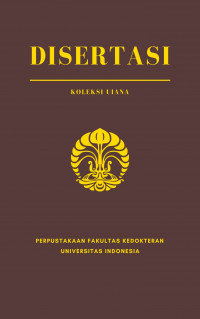Disertasi
Pengembangan Antiviral Avian Influenza Berbasis Sialidase Asal Bakteri Pasteurella multocida: Fokus pada Pengujian secara In Vitro terhadap Infeksi Subtipe H9N2. = Development of Sialidase-Based Avian Influenza Antiviral from Pasteurella multocida: Focus on In Vitro Testing against H9N2 Subtype Infection.
Latar Belakang: Avian influenza merupakan penyakit infeksius yang mudah menular secara aerosol. Salah satu subtipenya yakni H9N2 mewabah pertama kali di wilayah peternakan unggas di Indonesia pada tahun 2016 dan dilaporkan membawa gen yang cenderung menginfeksi sel mamalia. Antiviral berbasis sialidase dikembangkan sebagai pencegahan dan pengobatan infeksi virus saluran pernapasan seperti avian influenza yang membutuhkan sialic acid sebagai pintu masuknya virus ke dalam sel. Penelitian ini bertujuan mengembangkan antiviral berbasis sialidase asal bakteri Pasteurella multocida, khususnya terhadap infeksi subtipe H9N2. Metode: Penelitian diawali dengan kultur Pasteurella multocida yang secara genetik hanya mengandung satu jenis sialidase yakni NanB. Sialidase dipurifikasi melalui metode kloroform, dan dilanjutkan dengan ion exchange chromatography dan affinity chromatography. NanB sialidase yang dihasilkan diuji aktivitasnya pada suhu, pH dan lama waktu inkubasi yang berbeda. Uji toksisitas dan spesifisitas NanB sialidase dilakukan dengan menggunakan berbagai dosis sialidase pada media sel darah merah ayam dan kelinci serta sel MDCK. Dilanjutkan dengan uji hambatan infeksi virus avian influenza H9N2 dan ekspresi gen penyandi apoptosis sebagai respon sel terhadap infeksi avian influenza H9N2. Hasil: Pasteurella multocida B018 terbukti menghasilkan NanB sialidase dengan berat molekul sekitar 55 kDa. NanB sialidase yang dihasilkan bersifat stabil pada suhu 37℃ dan pH 5 hingga 7 meskipun mengalami penurunan aktivitas pada 72 jam inkubasi. Dosis 0.258 U/ml merupakan dosis toksik yang melisiskan sel darah merah dan merusak sel MDCK. Dosis efektif yang mampu menghirolisis sialic acid adalah 0.129 U/ml, namun NanB sialidase cenderung menghidrolisis sialic acid Neu5Acα(2,6)-Gal pada mamalia. Dosis tersebut juga mampu menghambat ikatan virus H9N2 pada sel darah merah serta menekan jumlah infeksi virus pada sel MDCK tanpa menyebabkan peningkatan ekspresi gen penyandi apoptosis sel. Kesimpulan: NanB Sialidase asal bakteri Pasteurella multocida berpotensi sebagai antivirus avian influenza melalui hilangnya sialic acid akibat proses hidrolisis yang terjadi.
Kata Kunci: NanB sialidase, H9N2, Antiviral, Pasteurella multocida, In vitro.
Background: Avian influenza is an infectious disease easily transmitted by aerosol. One of the subtypes, H9N2, first appeared in poultry farming areas in Indonesia in 2016 and was reported to carry a gene that tends to infect mammalian cells. Sialidase-based antivirals were developed to prevent and treat viral respiratory infections such as avian influenza, which require sialic acid as the entry point for viruses to enter cells. This study aims to develop a sialidase-based antiviral from the Pasteurella multocida, especially against infection with the H9N2 subtype. Methods: The research started with Pasteurella multocida culture, which contains only one type of sialidase, NanB. Sialidase was purified by the chloroform method and followed by ion-exchange chromatography and affinity chromatography. NanB sialidase was tested for its activity at different temperatures, pH, and incubation times. The toxicity and specificity test of NanB sialidase was carried out using various doses of sialidase on chicken and rabbit red blood cells and MDCK cells, followed by the inhibition test of avian influenza H9N2 virus infection and expression of apoptotic coding genes as a cell response to avian influenza H9N2 infection. Results: Pasteurella multocida B018 produced NanB sialidase with a molecular weight of about 55 kDa. The resulting NanB sialidase was stable at 37℃ and pH 5 to 7, although it decreased in activity at 72 hours of incubation. The dose of 0.258 U/ml is a toxic dose that lyses red blood cells and destroys MDCK cells. The effective dose capable of hydrolyzing sialic acid is 0.129 U/ml, but NanB sialidase tends to hydrolyze Neu5Acα(2,6)-Gal sialic acid in mammals. This dose also inhibited the binding of the H9N2 virus on red blood cells. It suppressed the number of viral infections in MDCK cells without increasing the expression of genes encoding cell apoptosis. Conclusion: NanB Sialidase from Pasteurella multocida has the potential as an antiviral for avian influenza through the loss of sialic acid due to the hydrolysis process.
Keywords: NanB sialidase, H9N2, Antiviral, Pasteurella multocida, In vitro.
- Judul Seri
-
-
- Tahun Terbit
-
2022
- Pengarang
-
Christian Marco Hadi Nugroho - Nama Orang
Amin Soebandrio - Nama Orang
Silvia Tri Widyaningtyas - Nama Orang
I Wayan Teguh Wibawan - Nama Orang - No. Panggil
-
D22012fk
- Penerbit
- Jakarta : Program Doktor Ilmu Biomedik., 2022
- Deskripsi Fisik
-
xix, 158 hlm. ; 21 x 30 cm
- Bahasa
-
Indonesia
- ISBN/ISSN
-
-
- Klasifikasi
-
NONE
- Edisi
-
-
- Subjek
- Info Detail Spesifik
-
Tanpa Hardcopy
| D22012fk | D22012fk | Perpustakaan FKUI | Tersedia |


Masuk ke area anggota untuk memberikan review tentang koleksi